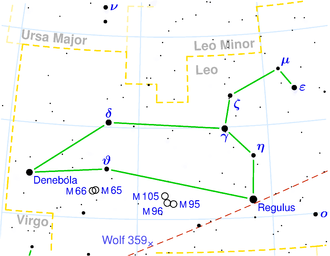NGC 3808
| Galaxy NGC 3808 |
|
|---|---|

|
|
| The galaxies NGC 3808 (right) and NGC 3808A (left) captured by the Hubble Space Telescope | |
| AladinLite | |
| Constellation | lion |
|
Position equinox : J2000.0 , epoch : J2000.0 |
|
| Right ascension | 11 h 40 m 44.2 s |
| declination | + 22 ° 25 ′ 46 ″ |
| Appearance | |
| Morphological type | SAB (rs) c: / pec / HII |
| Brightness (visual) | 13.4 mag |
| Brightness (B-band) | 14.1 mag |
| Angular expansion | 1.6 ′ × 0.9 ′ |
| Position angle | 0 ° |
| Surface brightness | 13.6 mag / arcmin² |
| Physical data | |
| Redshift | 0.023726 ± 0.000100 |
| Radial velocity | 7113 ± 30 km / s |
|
Stroke distance v rad / H 0 |
(316 ± 22) · 10 6 ly (96.9 ± 6.8) Mpc |
| history | |
| discovery | Wilhelm Herschel |
| Discovery date | April 10, 1785 |
| Catalog names | |
| NGC 3808 • UGC 6643 • PGC 36227 • CGCG 127-025S • MCG + 04-28-21 • Arp 87 • VV 300a • GC 2497 • H III 338 • KCPG 297A • PRC D-19 • LDCE 0823 NED011 | |
NGC 3808 is a bar-spiral galaxy with extensive star formation regions of the Hubble type SBc / P in the constellation Leo north of the ecliptic . It is an estimated 316 million light years from the Milky Way and about 150,000 light years in diameter. Together with PGC 36228 ( NGC 3808A ) it forms the interacting galaxy pair ARP 87 or KPG 297 .
Halton Arp organized his catalog of unusual galaxies into groups according to purely morphological criteria. This galaxy belongs to the class spiral galaxies with a large companion of high surface brightness on one arm (Arp catalog) .
In the same area of the sky are u. a. the galaxies NGC 3832 , NGC 3748 , NGC 3754 , NGC 3772 .
The Type IIP supernova SN 2013db was observed here.
The object was discovered on April 10, 1785 by the German-British astronomer Wilhelm Herschel .
literature
- Jeff Kanipe and Dennis Webb: The Arp Atlas of Peculiar Galaxies - A Chronicle and Observer's Guide , Richmond 2006, ISBN 978-0-943396-76-7
